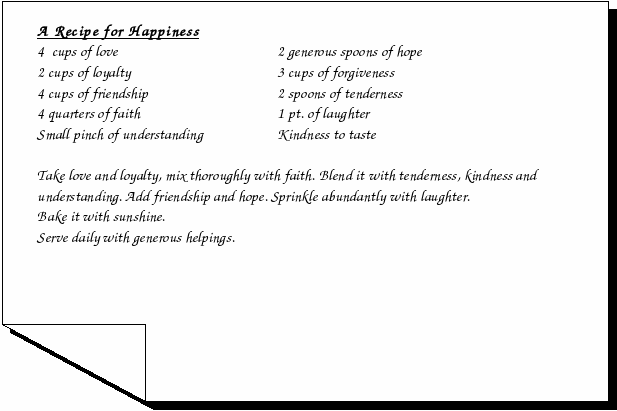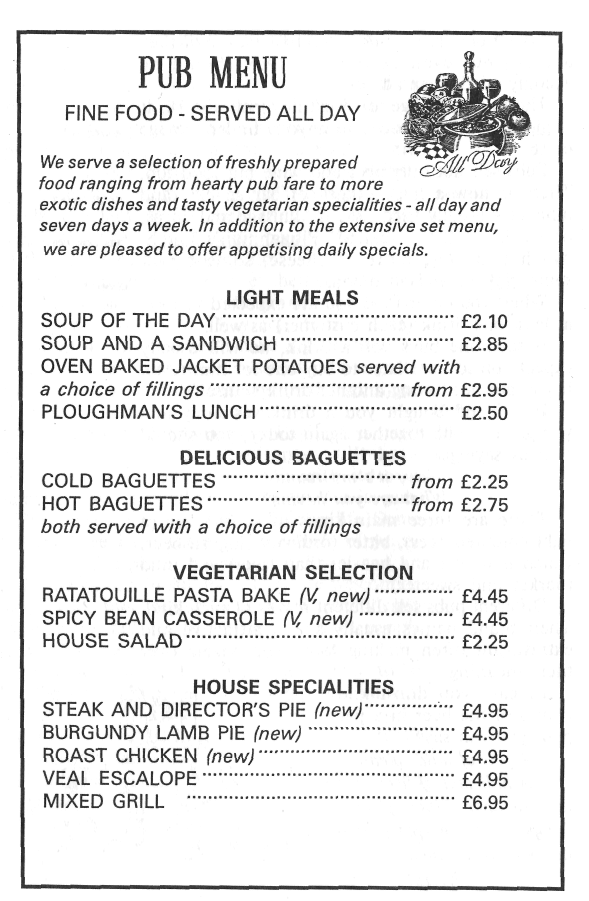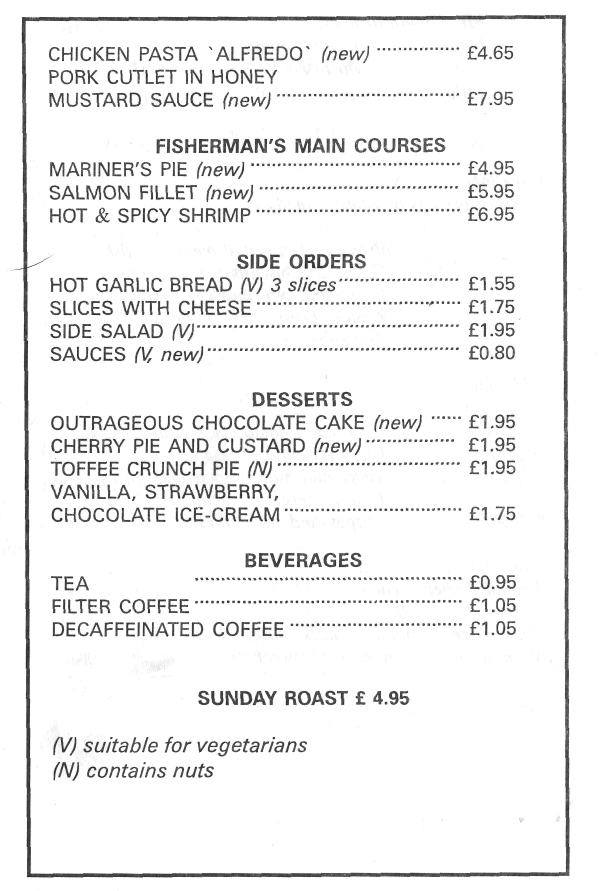Пособие по обучению практике устной и письменной речи (начальный этап) на английском языке Под ред. О. В. Серкиной
 Скачать 17.03 Mb. Скачать 17.03 Mb.
|
|
Paying the bill We’ll split the bill, shall we? (= each person will pay for him/herself) Lunch is on me today. (informal: = I am paying for you) Will you join us (= come with us) for dinner at the City Plaza hotel? We’d like you to be our guest. (formal: = we will pay) Let me get this. (informal:= pay the bill this time) I was wined and dined every night by our New York office (=invited out to restaurants). Situations: 1. You are having your dinner with a friend and discuss paying the bill. 2. You came to a new country earlier today and you would like to try some local dishes. You’ve dropped in some local restaurant and now are talking to a waiter. Ask him about specialties and what he could recommend you. 3. You are calling a restaurant to book a table for four for this Saturday. Discuss all the details: the location of the table, the dishes – starters, main courses, desserts, alcohol. One of your friends is a vegan and she needs a special menu. 4. You are to arrange meals for the delegates to the conference. Ask them about their food preferences and make up a menu for the week. c) In groups of three use the prompts below to act out a conversation. Diners You are colleagues from work/ a couple/ business associates having dinner at the restaurant. You are both very hungry/quite hungry/ very hungry. One of you is a vegetarian/ is on a diet/ doesn’t drink alcohol. You think the food is excellent/ OK/ awful. Waiter/ waitress You are in good mood/ very, very tired/ very nervous (it’s your first day!) so you are going to be very polite/ a bit rude. You’re a very good / very bad waiter/waitress. You want to get a good tip/ go home as soon as possible. 1.34. Read this unusual menu and think of other national dishes. Try to describe them in a proper way to your foreign friend.
1.35. Work in a small group. Discuss the following topics. 1. My usual menu for breakfast/ lunch/ dinner. 2. The most popular dish in Russia/ The Russian staple food. 3. Food I avoid eating. 4. My favourite food. 5. The most beautiful/ my favourite café /restaurant in my city. 6. The market places in my city. 7. The dishes my family prefer on an ordinary day/ on a holiday/ for a party. 8. Popular diets (based on calorie-counting, blood group, etc.). 1.36. a) Comment on the following proverbs and sayings about food and dieting. Which one do you like best? Why? Which one do you disagree with? Explain your choice. Citations about food and dieting:
b) Think of situations which the following proverbs might suit.
1.37. Read the recipes below. Discuss them in class.
 b) Here is a recipe that Judie Flanigan received after she and her husband Matt were married. She says that it has worked well for over 30 years. Tenderizing a Husband Many husbands are spoilt by mismanagement. Some women keep them in hot water too long. Others freeze them. Some put them in a stew; others keep them in a pickle. No husband will be good and tender if managed this way, but he can be truly delicious if properly treated. Don’t keep him in the kettle by force. He will stay there if care is taken. If he should sputter or fizz, don’t become anxious. Some husbands do just this. Just add a little sugar; never add vinegar or pepper. A little spice improves him, but must be used with good judgment. Do not try him with something sharp to see if he is tender. Stir him gently lest he lies too long in the kettle and becomes flat and tasteless. If you follow these directions, you will find him very digestible, agreeing nicely with you, and he will keep indefinitely. WRITING 1.38. Read the description of service in one of the restaurants and describe service in one of your favourite restaurants. A new Italian restaurant called Bella Roma has just opened in the High Street, and we went there the other night to try it. I couldn’t help comparing it to the Casa Italia, where we ate last week. At the Bella Roma the service was impeccable and quick; at the Casa Italia it’s always a bit sluggish. In the new place the waiters are courteous and friendly without being overbearing. In the other place they tend to be sullen and the service is rather brusque, which I find very off-putting. But at the Bella Roma they’ll go out of their way to give you what you want. 1.39. Read some recipes from Margaret Fulton below and translate two recipes of your favourite smart dishes into English. Get smart! More and more cooks are wishing up to the benefits of healthy eating At cocktail parties, over dinner and at top restaurants, it seems there is a new word. It describes what some good cooks are doing and the word is ‘smart’. Smart food, it seems, is high in protein, high in fibre; it is light and energy-producing. Smart people want to eat it to be fit and to excel. Smart cooks are trimming excess fat; meat is lightly cooked and served with a fresh tasting sauce. Grains are turning up with many dishes; vegetables are chosen and cooked with great care. Salad Dorzia 1.5 cups long-grain rice 1 teaspoon salt 1 cucumber 3 chicken breast fillets, poached Vinaigrette 1/3 cup olive oil 1 tablespoon wine vinegar 1 teaspoon French-style mustard 1 teaspoon chopped capers 1 tablespoon chopped fresh parsley 1 teaspoon each chopped fresh tarragon and chives 1 medium red salad onion, peeled and finely chopped Salt and freshly ground pepper Wash rice well. Bring 4.5 cups water to the boil, add 1 teaspoon salt and sprinkle in the rice. Allow water to return to the boil, stir once, turn heat as low as possible and cover with lid. Steam gently for 18-20 minutes. Remove from the heat, uncover and fluff up with a fork. Peel the cucumber, cut in half lengthwise, remove the seeds, then cut it into thick slices. Place these in a colander, slightly salt and leave for 10-15 minutes to drain. Rinse and remove from the colander, pat dry with a clean tea-towel or kitchen towel and put in a salad bowl. Burpless cucumbers do not require this process; simply peel and slice. Cut the poached chicken into thin strips and add these to the cucumber along with the cooked rice. Make the vinaigrette by whisking all the ingredients together thoroughly. Pour over the salad and mix lightly. Serves 4-6. To poach chicken breasts: Put 1 cup water, 0.5 onion, 0.5 bay leaf, a few peppercorns, and a few celery leaves in a saucepan. Bring to the simmer and add the chicken breasts. Bring back to the simmer, cover and poach gently for 6-8 minutes. Cool in liquid. Remove bones and slice the meat. Brown and Wild Rice Brown and wild rice mixtures have become popular. This is the mixture I use. It has a delicious, nutty texture. 1 teaspoon salt 1 cup long-grain brown rice 0.5 cup wild rice 1 tablespoon butter, optional Bring 6 cups water to the boil, add salt and the brown rice, then simmer gently for 20 minutes. Add the wild rice and simmer a further 20-25 minutes or until both grains are tender. Drain well, return to pan and heat through. You may toss through a tablespoon of butter. 1.40. This is a healthy diet for one day. Write down a typical day’s diet for yourself and see how healthy you are. Eating a Healthy Diet Breakfast Orange, apple or grapefruit juice. Whole grain cereal. Fruit (apple, raisins) Nuts (hazels, almonds) Milk, coffee or tea A slice of wholemeal toast with butter/margarine and marmalade. Mid Morning Coffee or tea Lunch Cheese or an egg Mixed salad with lettuce, tomatoes, onions, celery, dressed with vegetable oil, salt and lemon juice A slice of whole meal bread with butter/margarine Fresh fruit A glass of wine Mid Afternoon Tea or coffee Dinner Grapefruit or clear vegetable soup Meat, fish or poultry Root vegetables e.g. potatoes, carrots, onions, plus leaf vegetables e.g. cabbage, spinach, cauliflower Dessert made with unrefined flour, cereal, sugar and chocolate A glass of wine 1.41. Read an abstract from the menu of a pub in Britain. Imagine that you are going to start your own business – a restaurant or a bar. Make up a menu for your enterprise. Be sure to show all the courses you are going to offer, including dessert and beverages. Think of a name for your restaurant/ bar.   1.42. Write a 300-word essay on one of the following topics using the hints below. 1. My Favourite Food. - Where do /did you buy or eat the food? - How much does/ did the food cost? - Do /Did you eat or drink anything with the food? - Do/ Did you do anything to show that you were enjoying the food? If so, what? 2. My Favourite Place to Eat. - Where is /was the place? - When do / did you go there? - What does /did the place look like? - How does /did the place smell? 3. My Food Experience. Write about a funny or embarrassing food experience. Consider the following questions. - What happened? Was it funny or embarrassing? - How did other people react? - What did you learn? 4. Eating Customs. Describe one or several eating customs. 5. Table manners. Imagine that you have been asked to write a description of table manners that are considered polite or impolite in Russia. This information will appear in a guid for people travelling in our country. You can start with filling the chart with “Dos” and “Don’ts” of table manners.
1.43. Find some information about one of the following special foods, eating rituals, or customs. Write a short report about it and share with class. 1) breaking plates in Greek restaurants 9) paella 2) buffet dinners 10) potluck dinners 3) BYOB parties 11) roasting marshmallows 4) cappuccino coffee or coffee latte 12) Sangria 5) setting the North American table 13) smorgasbord 6) Chinese tea ceremony 14) wine tasting 7) hot pots 15) Japanese tea or sake ceremonies 8) mate drinking in Argentina, 16) Oktoberfest Brazil, and Paraguay 1.44. Render the texts in English. 1) Советы от знаменитого доктора Анатолия Волкова, у которого уже более 20 лет худеет и оздоравливается практически вся светская Москва, представители политической и бизнес-элиты. Нельзя есть и пить: 1. Консервы. Это изначально еда для выживания, а не на каждый день. Она не имеет вообще никаких преимуществ перед свежей, кроме срока хранения. Это относится не только к шпротам и кукурузе в баночке, но и к сокам - их тоже нужно пить свежеотжатыми. 2. Тушеное мясо и рыбу. Это та же консервированная тушенка, только без банки. За время тушения свежий продукт разрушается как структура. Мясо и рыбу можно готовить на пару, на гриле, в духовке, на открытом огне, а также солить, вялить и, в крайнем случае, варить. 3. Бульон (ни рыбный, ни мясной) - в нем концентрат всего самого ненужного, что содержится в этих продуктах. Единственное исключение - куриный бульон. 4. Жарить на масле: нерафинированное масло холодной выжимки на сковородке горит, а рафинированное - бессмысленный продукт. 5. Копченое (особенно в заводских условиях) - это опять-таки мертвая еда длительного хранения. 6. Молоко. Это еда для детенышей коровы. 7. Пить одновременно с едой ничего, кроме воды и зеленого чая, да и то понемногу. Черный чай, кофе, сок - либо за полчаса до еды, либо через час после. Алкоголь желательно не употреблять вовсе, но если уж очень хочется... Крепкие напитки лучше пить после еды, а вино - отдельно, с фруктами. 8. Газированную воду, пусть даже минеральную. Из нее удален кислород. А вода - это такая структура, которая обязана его набрать. Значит, попав внутрь, она наберет его там, что не есть полезно. Нужно: 1. Максимально быстро готовить еду, тогда она легче воспринимается организмом. 2. Самостоятельно выбирать режим питания. Между приемами пищи должно проходить не меньше двух часов (после мяса - не меньше трех), чтобы все успело перевариться. 3. Есть как можно более разнообразно. 4. Раз в день обливаться холодной водой. Казалось бы, к питанию это не имеет никакого отношения. Однако обливания стимулируют иммунитет. А значит, и перевариваться все будет лучше. 2) Почему дома есть лучше, чем в фаст-фуде Современному человеку все чаще приходится есть вне дома. Покидая его утром и возвращаясь поздно вечером, мы вынуждены где-то перекусывать. А традиции неспешной еды уходят в прошлое, уступая место индустрии быстрого питания – фаст-фуду. К сожалению, обед из такого кафе-забегаловки по определению не может быть полноценным. Предлагаемые в таких заведениях бургеры, пирожки и прочие блюда кажутся вкусными, но при частом употреблении очень вредны для здоровья. В такой пище чрезмерное содержание холестерина. Такая пища непозволительно высококалорийна, в ней снижено содержание витаминов, а баланс между белками, жирами и углеводами утрачен. К тому же посетители фаст-фуда едят наспех, толком не пережевывая пищу. В желудок попадают неизмельченные или плохо измельченные продукты, что вызывает проблемы с работой желудочно-кишечного тракта. Еще одним недостатком торопливой еды является замедленное наступление насыщения. А отсюда – переедание. Готовя дома, пусть даже на скорую руку, вы сами имеете возможность сбалансировать свое питание. К тому же даже 5-10 минут, потраченных вами на приготовление пищи, оказывается достаточно, чтобы переждать острую вспышку голода, когда хочется съесть все, что под рукой. | ||||||
